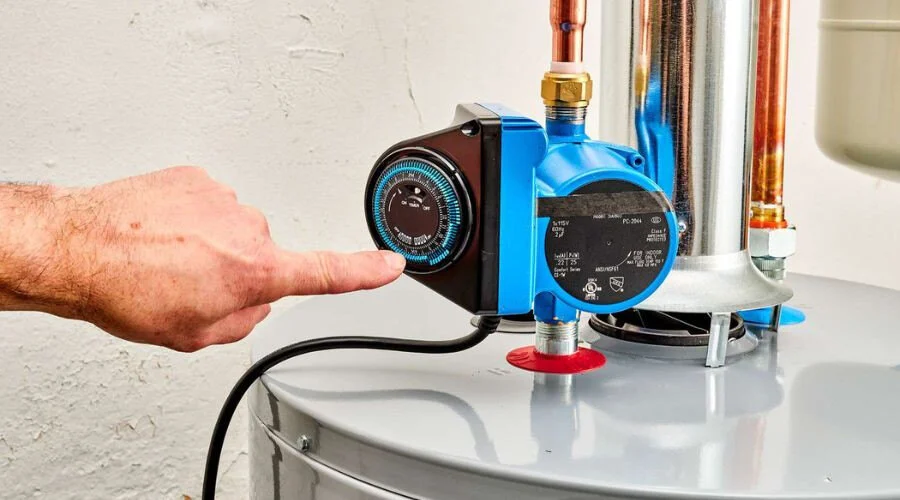A hot water circulation pump is an essential device used in plumbing systems to ensure hot water is readily available at your faucets and showers without any delay. This system eliminates the need to wait for the water to heat up, saving both time and water. The pump works by circulating hot water continuously or on demand through your home’s plumbing system, delivering convenience and efficiency.
How Does a Hot Water Circulation Pump Work?
The hot water circulation pump operates by creating a loop in your plumbing system. Hot water from the water heater is circulated through the pipes, and any unused water is returned to the heater to maintain a constant temperature. This ensures that when you turn on a tap, hot water is instantly available.
Modern circulation pumps often come with features such as timers, sensors, and thermostats to improve efficiency and reduce energy consumption. These components allow homeowners to control when the pump operates, ensuring it only works when needed.
Benefits of Installing a Hot Water Circulation Pump
1. Instant Hot Water
One of the primary benefits of a hot water circulation pump is the convenience of having hot water on demand. Whether you’re washing dishes or taking a shower, you no longer have to wait for the water to heat up.
2. Water Conservation
Without a circulation pump, cold water in the pipes is wasted while you wait for hot water to arrive. A hot water circulation pump eliminates this waste, significantly reducing water consumption and benefiting the environment.
3. Energy Efficiency
While older models of circulation pumps operated continuously, newer versions are designed to be energy-efficient. Pumps with timers or motion sensors ensure they only operate when necessary, helping to lower energy bills.
4. Increased Comfort
A hot water circulation pump enhances comfort by providing hot water instantly. This is particularly beneficial in homes with multiple bathrooms or distant faucets from the water heater.
Types of Hot Water Circulation Pumps
1. Traditional Circulation Pumps
These pumps continuously circulate hot water through the plumbing system, ensuring constant availability. However, they may consume more energy compared to other types.
2. On-Demand Circulation Pumps
On-demand pumps activate only when needed, such as when a faucet is turned on. They are more energy-efficient and environmentally friendly.
3. Timer-Controlled Pumps
These pumps operate based on a pre-set schedule, allowing homeowners to control when hot water is circulated. This is ideal for households with predictable water usage patterns.
4. Thermostat-Controlled Pumps
Thermostat-controlled pumps maintain water at a specific temperature. They operate only when the water temperature drops below a certain level, optimizing energy use.
Installation of a Hot Water Circulation Pump
Installing a hot water circulation pump can vary in complexity depending on your plumbing system. It is typically recommended to hire a professional plumber to ensure proper installation. Here are the basic steps involved:
- Identify the Installation Point: The pump is usually installed near the water heater or at the furthest fixture from the heater.
- Connect the Pump: Attach the pump to the hot water line and connect it to a power source.
- Install a Return Line: In some systems, a dedicated return line may be needed to complete the loop.
- Configure the Pump Settings: Set timers, sensors, or thermostats as per your preferences.
- Test the System: Run the system to ensure hot water circulates effectively and there are no leaks.
Maintenance Tips for Hot Water Circulation Pumps
Regular maintenance ensures the longevity and efficiency of your hot water circulation pump. Here are some tips:
- Inspect for Leaks: Regularly check the pump and plumbing connections for any leaks.
- Clean the Pump: Remove debris or sediment that may accumulate in the pump over time.
- Test Timers and Sensors: Ensure that the pump’s controls are functioning correctly.
- Schedule Professional Servicing: Periodically have the pump inspected by a professional to address any potential issues.
Cost of Hot Water Circulation Pumps
The cost of a hot water circulation pump depends on factors such as the type, brand, and installation complexity. On average, the pump itself can range from $200 to $500. Installation costs may vary based on your home’s plumbing system and can range from $200 to $1,000.
While the initial investment may seem high, the long-term savings in water and energy make it a cost-effective solution. Additionally, many energy-efficient models qualify for rebates or incentives, further reducing the overall cost.
Factors to Consider When Choosing a Hot Water Circulation Pump
When selecting a hot water circulation pump, consider the following factors:
- Energy Efficiency: Look for pumps with high energy ratings or certifications.
- Compatibility: Ensure the pump is compatible with your plumbing system.
- Features: Consider models with advanced features like timers, sensors, and remote control.
- Noise Level: Opt for a pump with quiet operation, especially for residential use.
- Warranty: Check for a comprehensive warranty to protect your investment.
Conclusion
A hot water circulation pump is a valuable addition to any home, offering convenience, water conservation, and energy efficiency. By eliminating the wait for hot water, it enhances comfort and helps reduce utility bills. With various types and advanced features available, homeowners can choose a pump that best suits their needs. While the initial cost may be a consideration, the long-term benefits make it a worthwhile investment for modern households. By maintaining your pump regularly and choosing energy-efficient models, you can enjoy hot water on demand while contributing to a more sustainable future.

